7954
Views & Citations6954
Likes & Shares
The 6-Mercaptopurine, an antineoplastic agent, is useful for the treatment of many diseases. This study was performed to investigate the impact of The Trivedi Effect®-Biofield Energy Healing Treatment on the structural properties and the isotopic abundance ratio of 6-mercaptopurine using liquid chromatography-mass spectrometry (LC-MS) and gas chromatography-mass spectrometry (GC-MS) spectroscopy. The 6-mercaptopurine sample was divided into two parts - one part was considered as a control sample (i.e., no Biofield Energy Treatment was provided), while the other part was considered as a treated sample (i.e., treated with The Trivedi Effect®-Consciousness Energy Healing Treatment remotely by a renowned Biofield Energy Healer, Alice Branton). The LC-MS spectra of both the samples at retention time (Rt) 2.24 minutes exhibited the mass of the protonated molecular ion peak at m/z 153 [M+H] + (calculated for C5H5N4S+, 153.18). The LC-MS based isotopic abundance ratio of PM+1/PM (2H/1H or 13C/12C or 15N/14N or 33S/32S) in the treated 6-mercaptopurine was significantly decreased by 42.49% compared with the control sample. Thus, 13C, 2H, 15N, and 33S contributions from (C5H5N4S) + to m/z 154 in the treated sample were significantly decreased compared with the control sample. The GC-MS based isotopic abundance ratio of PM+1/PM in the treated 6-mercaptopurine was decreased by 1.34% compared with the control sample. Hence, 13C, 2H, 15N, and 33S contributions from (C5H5N4S)+ to m/z 153 in the treated sample were significantly decreased compared with the control sample. However, the isotopic abundance ratio of PM+2/PM in the treated 6-mercaptopurine was significantly increased by 11.58% compared with the control sample. Therefore, 18O contributions from (C5H5N4S) + to m/z 154 in the treated sample were significantly increased compared with the control sample. The isotopic abundance ratio of PM+1/PM (2H/1H or 13C/12C or 15N/14N or 33S/32S) and PM+2/PM (34S/32S) in the treated 6-mercaptopurine was significantly altered compared to the control sample. It can be assumed that the changes in isotopic abundance and mass peak intensities could be due to changes in nuclei possibly through the interference of neutrino particles via The Trivedi Effect® - Consciousness Energy Healing Treatment. The new form of treated 6-mercaptopurine would be better in designing novel pharmaceutical formulations that might offer a better therapeutic response against acute lymphocytic leukemia, chronic myeloid leukemia, Crohn's disease, ulcerative colitis, etc.
Keywords: 6-Mercaptopurine, The Trivedi Effect®, Biofield Energy, Consciousness Energy Healing Treatment, LC-MS, GC-MS
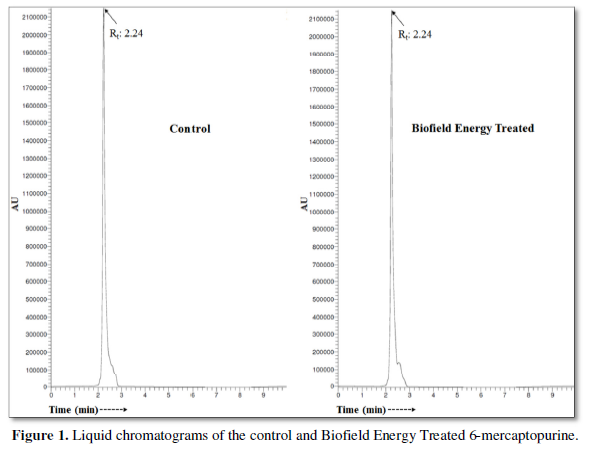
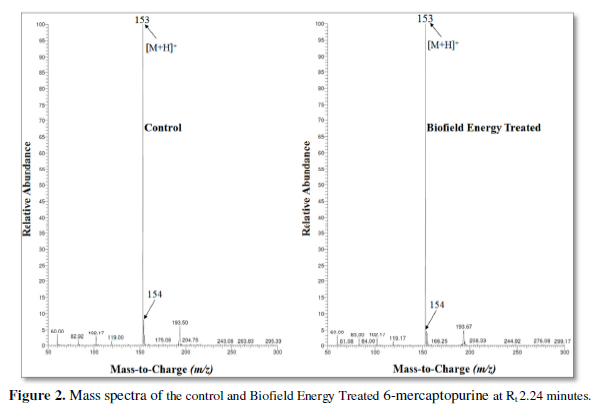
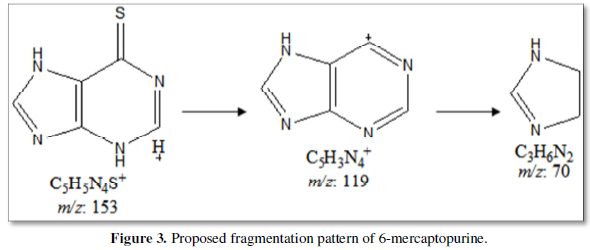
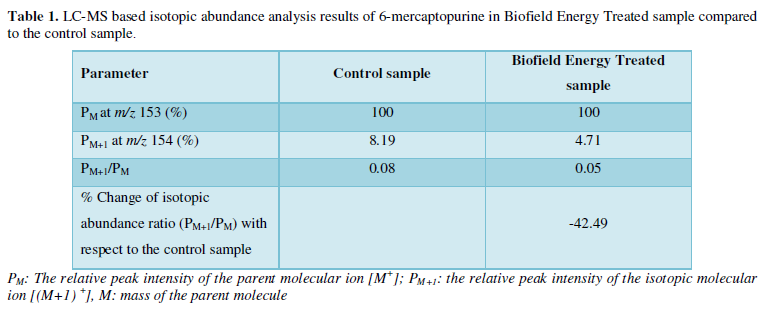
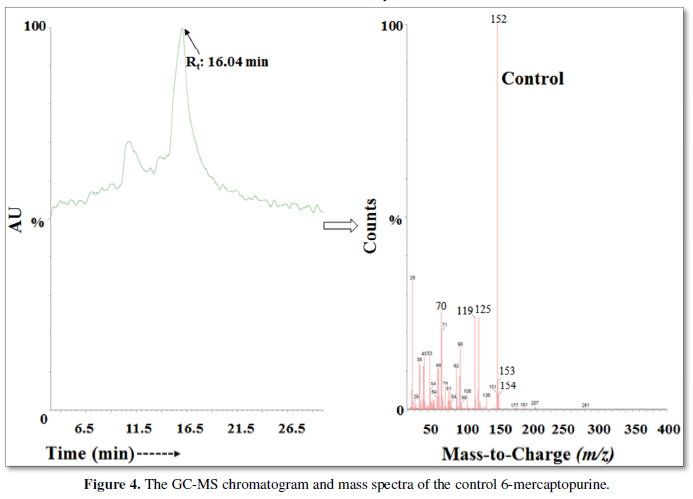
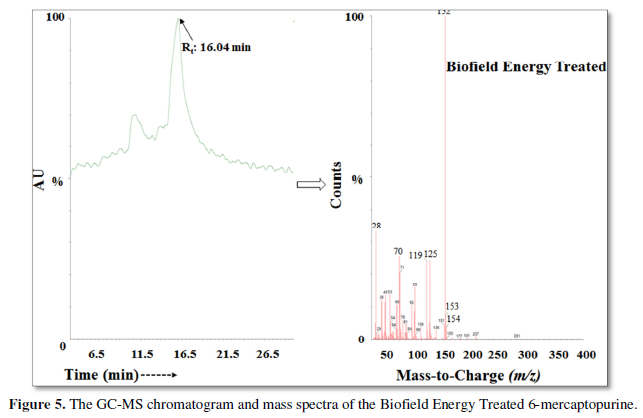
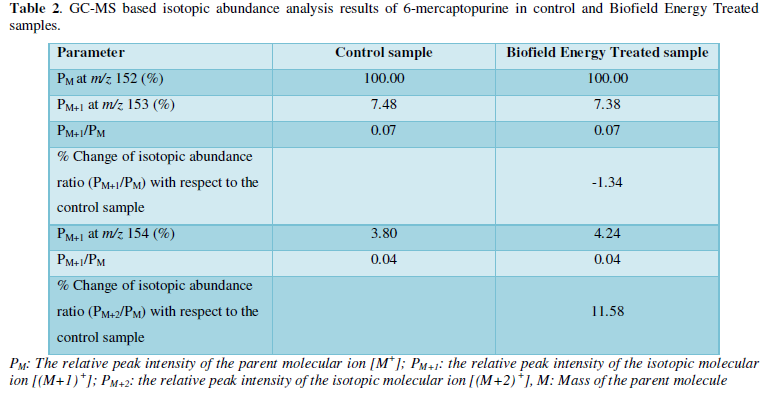
- Salser JS, Balis ME (1965) The Mechanism of Action of 6-Mercaptopurine: I. Biochemical Effects. Cancer Res 25: 539-543.
- Dubinsky MC (2004) Azathioprine, 6-mercaptopurine in inflammatory bowel disease: Pharmacology, efficacy and safety. Clin Gastroenterol Hepatol 2(9): 731-743.
- Present DH, Korelitz BI, Wisch N, Glass JL, Sachar DB, et al. (1980) Treatment of Crohn’s disease with 6-mercaptopurine: A long-term, randomized, double-blind study. N Engl J Med 302: 981-987.
- Schmiegelow K, Glomstein A, Kristinsson J, Björk O, Salmi T, et al. (1997) Impact of morning versus evening schedule for oral methotrexate and 6-mercaptopurine on relapse risk for children with acute lymphoblastic leukemia. Nordic Society for Pediatric Hematology and Oncology (NOPHO). J Pediatr Hematol Oncol 19: 102-109.
- Sack DM, Peppercorn MA (1983) Drug therapy of inflammatory bowel disease. Pharmacotherapy 3: 158-176.
- World Health Organization (2015) 19th WHO Model List of Essential Medicines (April 2015). Available online at: https://www.who.int/medicines/publications/essentialmedicines/EML2015_8-May-15.pdf
- Mercaptopurine (2020) Available online at: https://en.wikipedia.org/wiki/Mercaptopurine
- Yang JJ, Landier W, Yang W, Liu C, Hageman L, et al. (2015) Inherited NUDT15 variant is a genetic determinant of mercaptopurine intolerance in children with acute lymphoblastic leukemia. J Clin Oncol 33: 1235-1242.
- Moriyama T, Nishii R, Perez-Andreu V, Yang W, Klussmann FA, et al. (2016) NUDT15 polymorphisms alter thiopurine metabolism and hematopoietic toxicity. Nature Genet 48: 367-373.
- Lerner EI, Flashner-Barak M, Achthoven EV, Keegstra H, Smit R (2012) Formulations of 6-mercaptopurine. US patent US8188067 B2.
- Ade TB, Hjalgrim LL, Nersting J, Breitkreutz J, Nelken B, et al. (2016) Evaluation of a pediatric liquid formulation to improve 6-mercaptopurine therapy in children. Eur J Pharm Sci 83: 1-7.
- National Center for Biotechnology Information (2020). PubChem Compound Summary for CID 667490, Mercaptopurine. Available online at: https://pubchem.ncbi.nlm.nih.gov/compound/Mercaptopurine
- Chereson R (2009) Basic pharmacokinetics. 1st Pharmaceutical Press, London.
- Trivedi MK, Patil S, Shettigar H, Bairwa K, Jana S (2015) Spectroscopic characterization of biofield treated 6-mercaptopurine and tinidazole. Med Chem 5: 340-344.
- Trivedi MK, Mohan R, Branton A, Trivedi D, Nayak G, et al. (2015) Evaluation of biofield energy treatment on physical and thermal characteristics of selenium powder. J Food Nutr Sci 3: 223-228.
- Branton A, Jana S (2017) The influence of energy of consciousness healing treatment on low bioavailable resveratrol in male Sprague Dawley Int J Clin Dev Anatomy 3: 9-15.
- Trivedi MK, Branton A, Trivedi D, Nayak G, Panda P, et al. (2016) Evaluation of the isotopic abundance ratio in biofield energy treated resorcinol using gas chromatography-mass spectrometry techniq Pharm Anal Acta 7: 481.
- Trivedi MK, Branton A, Trivedi D, Nayak G, Sethi KK, et al. (2016) Determination of isotopic abundance ratio of biofield energy treated 1,4-dichlorobenzene using gas chromatography-mass spectrometry (GC-MS). Mod Chem 4: 30-37.
- Trivedi MK, Mohan TRR (2016) Biofield energy signals, energy transmission and neutrinos. Am J Mod Phys 5: 172-176.
- Rubik B (2002) The biofield hypothesis: Its biophysical basis and role in medicine. J Altern Complement Med 8: 703-717.
- Nemeth L (2008) Energy and biofield therapies in practice. Beginnings 28: 4-5.
- Rivera-Ruiz M, Cajavilca C, Varon J (2008) Einthoven's string galvanometer: The first electrocardiograph. Tex Heart Inst J 35: 174-178.
- Rubik B, Muehsam D, Hammerschlag R, Jain S (2015) Biofield science and healing: History, terminology and concepts. Glob Adv Health Med 4: 8-14.
- Koithan M (2009) Introducing complementary and alternative therapies. J Nurse Pract 5: 18-20.
- Barnes PM, Bloom B, Nahin RL (2008) Complementary and alternative medicine use among adults and children: United States, 2007. Natl Health Stat Report 12: 1-23.
- Trivedi MK, Tallapragada RM (2008) A transcendental to changing metal powder characteristics. Met Powder Rep 63: 22-28.
- Trivedi MK, Nayak G, Patil S, Tallapragada RM, Latiyal O (2015) Studies of the atomic and crystalline characteristics of ceramic oxide nano powders after bio field treatment. Ind Eng Manage 4: 161.
- Trivedi MK, Nayak G, Patil S, Tallapragada RM, Latiyal O, et al. (2015) Effect of biofield energy treatment on physical and structural properties of calcium carbide and praseodymium oxide. Int J Mater Sci Appl 4: 390-395.
- Trivedi MK, Branton A, Trivedi D, Nayak G, Mondal SC, et al. (2015) Morphological characterization, quality, yield and DNA fingerprinting of biofield energy treated alphonso mango (Mangifera indica). J Food Nutr Sci 3: 245-250.
- Trivedi MK, Branton A, Trivedi D, Nayak G, Mondal SC, et al. (2015) Evaluation of biochemical marker-Glutathione and DNA fingerprinting of biofield energy treated Oryza sativa. Am J Bio Sci 3: 243-248.
- Trivedi MK, Branton A, Trivedi D, Nayak G, Charan S, et al. (2015) Phenotyping and 16S rDNA analysis after biofield treatment on Citrobacter braakii: A urinary pathogen. J Clin Med Genom 3: 129.
- Trivedi MK, Patil S, Shettigar H, Mondal SC, Jana S (2015) Evaluation of biofield modality on viral load of Hepatitis B and C viruses. J Antivir Antiretrovir 7: 083-088.
- Trivedi MK, Patil S, Shettigar H, Bairwa K, Jana S (2015) Phenotypic and biotypic characterization of Klebsiella oxytoca: An impact of biofield treatment. J Microb Biochem Technol 7: 203-206.
- Nayak G, Altekar N (2015) Effect of biofield treatment on plant growth and adaptation. J Environ Health Sci 1: 1-9.
- Ansari SA, Trivedi MK, Branton A, Trivedi D, Nayak G, et al. (2018) In vitro effects of biofield energy treated vitamin D3 supplementation on bone formation by osteoblasts cells. Biomed Sci 4: 10-17.
- Koster DA, Trivedi MK, Branton A, Trivedi D, Nayak G, et al. (2018) Evaluation of biofield energy treated vitamin D3 on bone health parameters in human bone osteosarcoma cells (MG-63). Biochem Mol Biol 3: 6-14.
- Trivedi MK, Patil S, Shettigar H, Mondal SC, Jana S (2015) The potential impact of biofield treatment on human brain tumor cells: A time-lapse video microscopy. J Integr Oncol 4: 141.
- Trivedi MK, Patil S, Shettigar H, Gangwar M, Jana S (2015) In vitro evaluation of biofield treatment on cancer biomarkers involved in endometrial and prostate cancer cell lines. J Cancer Sci Ther 7: 253-257.
- Schellekens RC, Stellaard F, Woerdenbag HJ, Frijlink HW, Kosterink JG (2011) Applications of stable isotopes in clinical pharmacology. Br J Clin Pharmacol 72: 879-897.
- Weisel CP, Park S, Pyo H, Mohan K, Witz G (2003) Use of stable isotopically labeled benzene to evaluate environmental exposures. J Expo Anal Environ Epidemiol 13: 393-402.
- Muccio Z, Jackson GP (2009) Isotope ratio mass spectrometry. Analyst 134: 213-222.
- Rosman KJR, Taylor PDP (1998) Isotopic compositions of the elements 1997 (Technical Report). Pure Appl Chem 70: 217-235.
- Smith RM (2004) Understanding Mass Spectra: A Basic Approach. Second Edition, John Wiley & Sons, Inc.
- Jürgen H (2004) Gross Mass Spectrometry: A Textbook 2nd Springer: Berlin.







